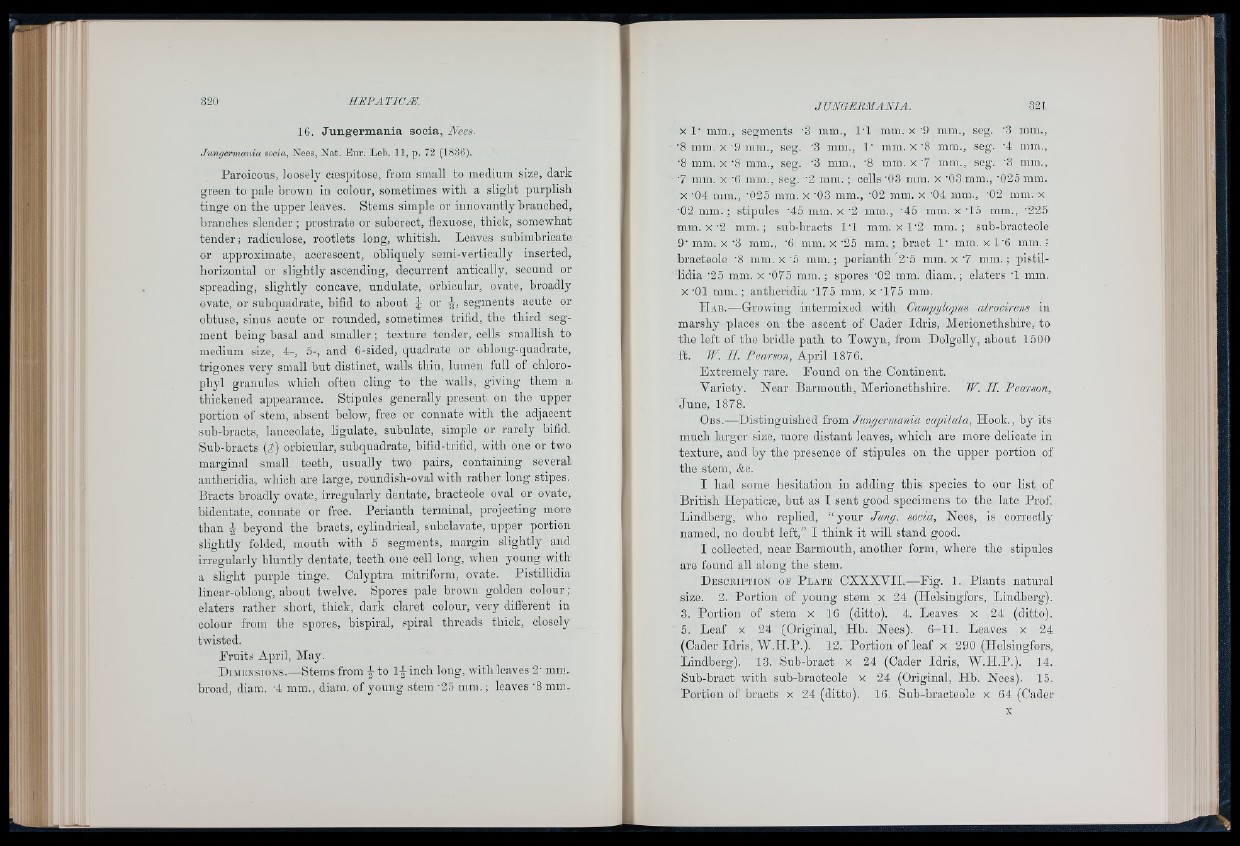
16. Jungermania socia, Nees.
Jungermania socia, Nees, Nat. Bur. Leb. 11, p. 72 (18S6).
Paroicous, ioosely cæspitose, from small to medium size, dark
green to pale brown in colour, sometimes with a slight purplish
tinge on the upper leaves. Stems simple or innovantly branched,
branches slender ; prostrate or suberect, fle.xuose, thick, somewhat
tender; radiculose, rootlets long, whitish. Leaves subimbricate
or approximate, accrescent, obliquely semi-vertically inserted,,
horizontal or slightly ascending, decurrent antically, secund or
spreading, slightly concave, undulate, orbicular, ovate, broadly
ovate, or subquadrate, bifid to about ^ or segments acute or
obtuse, sinus acute or rounded, sometimes trifid, the third segment
being basal and smaller ; texture tender, cells smallish to
medium size, 4-, 5-, and 6-sided, quadrate or oblong-quadrate,
trigones very small but distinct, walls thin, lumen full of ohloro-
phyl granules which often cling to the walls, giving them a
thickened appearance. Stipules generally present on the upper
portion of stem, absent below, free or connate with the adjacent
sub-bracts, lanceolate, ligulate, subulate, simple or rarely bifid.
Sub-bracts (/) orbicular, subquadrate, bifid-trifid, with one or two
marginal small teeth, usually two pairs, containing several
antheridia, which are large, roundish-oval with rather long stipes.
Bracts broadly ovate, irregularfy dentate, bracteole oval or ovate,
bidentate, connate or free. Perianth terminal, projecting more
than ^ beyond the bracts, cylindrical, subclavate, upper portion
slightly folded, month with 5 segments, margin slightly and
irregularly bluntly dentate, teeth one cell long, when young with
a slight purple tinge. Calyptra mitriform, ovate. Pistillidia
linear-oblong, about twelve. Spores pale brown golden colour ;
elaters rather short, thick, dark claret colour, very different in
colour from the spores, bispiral, spiral threads thick, closely
twisted.
Pruits April, May.
D imensions.— Stem s from J to 1J in c h lo n g , w ith le av e s 2- mm.
b ro a d , diam. -4 m m ., d iam . o f y o u n g s tem -25 mm . ; le av e s '8 mm.-
X 1' mm., segments '3 mm., I ’l mm. x ’9 mm., seg. '3 mm.,
•8 mm. X '9 mm., seg. '3 mra., 1' mm. x '8 mm., seg. ’4 mm.,
•8 mm. X ’8 mm., seg. '3 mm., '8 mm. x '7 mm., seg. '3 mm.,
’7 mm. X '6 mrn., seg. ’2 mm. ; cells '03 mra. x '03 mm., '025 mm.
X '04 mm., '025 mm, x '03 mm., '02 mm. x '04 mm., '02 mm. x
•02 mm.; stipules '45 mm. x '2 mm., '45 mm. x '15 mm., '225
mm. X'2 mm.; sub-braots I 'l mm. x 1'2 mm.; sub-bracteole
9' mm. X '3 mm., '6 nim. x '25 mm. ; braot 1' mm. x 1'6 mm. ;
bracteole '8 mm. x '5 mm. ; perianth '2'5 mm. x '7 mm. ; pistillidia
'25 mm. x '075 mm. ; spores '02 mm. diam. ; elaters '1 mm.
x '01 mm. ; antheridia '175 mm. x '175 mm.
P Iab.—Growing intermixed with Campijlopus atrovirens in
marshy places on the ascent of Cader Idris, Merionethshire, to
the left of the bridle path to Towyn, from Dolgelly, about 1500
ft. IF. II. Pearson, April 1876.
Extremely rare. Pound on the Continent.
Variety. Near Barmouth, Merionethshire. W. II. Pearson,
June, 1878.
O b s ,—Distinguished from Jungermania capitata. Hook., b y its
much larger size, more distant leaves, which are more delicate in
texture, and b y the presence of stipules on the upper portion of
the stem, &o.
I had some hesitation in adding this species to our list of
British Hepaticæ, but as I sent good specimens to the late Prof.
Lindberg, who replied, “ your Jung, socia, Nees, is correctly
named, no doubt left,” I think it will stand good.
I collected, near Barmouth, another form, where the stipules
are found all along the stem.
D escription op P late CXXXVII.—Pig. 1. Plants natural
size. 2. Portion of young stem x 24 (Helsingfors, Lindberg).
3. Portion of stem x 16 (ditto). 4. Leaves x 24 (ditto).
5. Leaf x 24 (Original, Hb. Nees). 6-11. Leaves x 24
(Cader Idris, W.H.P.). 12. Portion of leaf x 290 (Helsingfors,
Lindberg). 13. Sub-braot x 24 (Cader Idris, W.H.P.). 14.
Sub-bract with sub-braoteole x 24 (Original, Hb. Nees). 15.
Portion of bracts x 24 (ditto). 16. Sub-bracteole x 64 (Cader